

The Complete Guide to Thought Leadership for Your Business
source link: https://www.semrush.com/blog/complete-guide-to-thought-leadership-for-business/
Go to the source link to view the article. You can view the picture content, updated content and better typesetting reading experience. If the link is broken, please click the button below to view the snapshot at that time.
The Complete Guide to Thought Leadership for Your Business
Nov 15, 202120 min readThe term ‘thought leadership’ is getting increasingly abstract these days, as if we are forgetting its original meaning. The truth is, not every content piece that has some educational value or offers an opinion is true thought leadership.
And yet, brands are in desperate need to differentiate themselves from the competition and get their content in front of their target customers.
Thought leadership — when done right — can be an excellent way to reinforce your brand and enhance your content marketing strategy, allowing you to leverage your expertise and build trust with your audience.
So what, exactly, is thought leadership? And how can you apply it effectively in your business?
As always, we’re here to help! We surveyed over 300 marketers to learn about their approach to thought leadership and reached out to some industry experts to generate more actionable insights. Let's dive right in.
Create High-Performing Thought Leadership Content
Find winning content ideas, optimize your copy and boost its performance with Semrush Content Marketing Platform.

What Is Thought Leadership?
Within content marketing, there can be a lot of misconceptions around what thought leadership actually is. Some argue that it is about presenting strong (and often controversial) opinions in a piece of content, such as taking an outspoken stand on a contentious industry issue.
Others maintain that it is about being a subject matter expert (SME) and leveraging that position to wield influence within a particular niche. In reality, it’s a mix of both.
According to our research, thought leadership can be lots of things, and it’s especially about inspirational content that drives change and creates educational value.
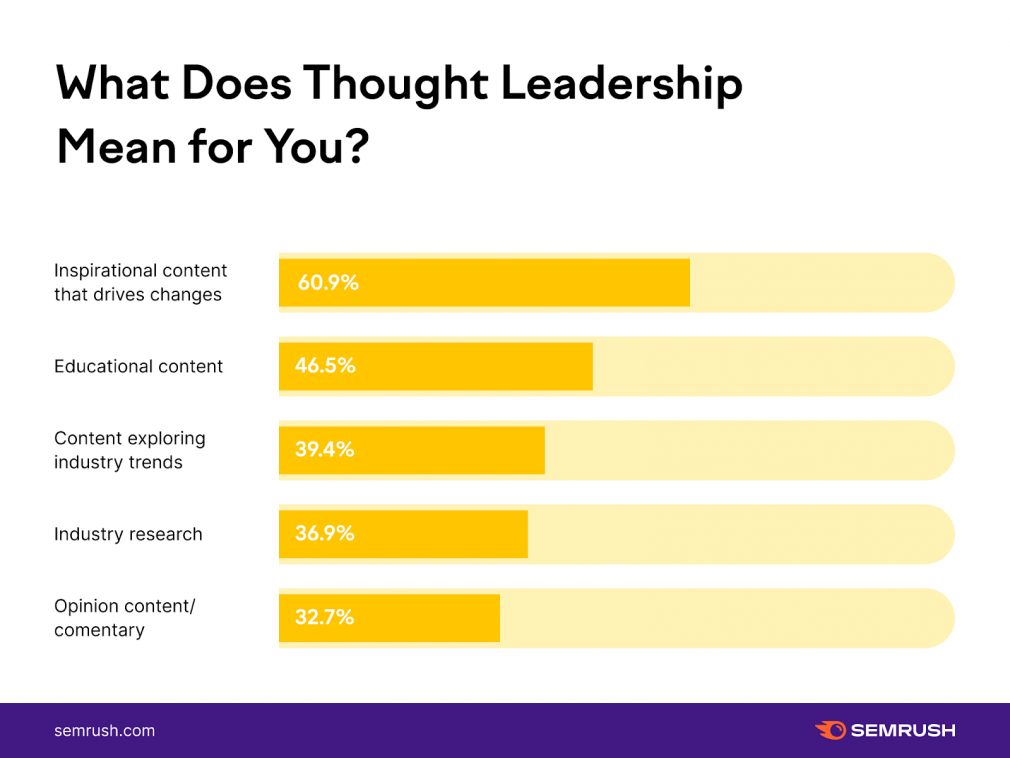
RaShea Drake, a marketing director at Essential Hub, agrees.
To me, thought leadership is about taking expertise, experience, and tools, and sharing actionable insights
RaShea Drake, a marketing director at Essential Hub
Thought leadership isn’t just about preaching to the masses, though. As Tim Gibbon, founder and director of Elemental Communications, explains:
There is also a strong cooperative element, with thought leadership allowing peers to collaborate, and share experiences, expertise, and knowledge.
Tim Gibbon, founder and director of Elemental Communications
In summary, thought leadership is the delivery of authentic and genuine content that leverages the expertise, insight, and experience of the author, with the goal of sharing that wisdom with others.
Who Are the Thought Leaders?
The best thought leaders, according to Orbit Media’s study, are defined simply as being experts in their field, which could be taken to mean CEOs, consultants, authors, or possibly even coaches. These are people that have strong opinions, experience, knowledge, and the desire to share it all with others.
Both Drake and Gibbon believe that expertise is the bare minimum, though; they assert that the best thought leaders offer transparency above all else.
Much of the thought leadership I see is so light, where the writers don’t share the real gems, tips, and actionable insights. True thought leaders are always ahead of the curve, and shouldn’t be concerned with giving away too much.
Tim Gibbon, founder and director of Elemental Communications
Anyone can brag about their accomplishments, but true thought leaders want others to succeed and offer the truth. What worked, what didn’t, and what they wished they had done differently. They’re as honest as they are effective.
RaShea Drake, a marketing director at Essential Hub
With this perspective in mind, it’s possible to identify a thought leader as anyone in a position of knowledge and expertise who has a real desire to impart that knowledge freely to others.
The good news is that according to the Orbit Media survey, 70% of respondents believe that thought leadership is not necessarily associated with a personal brand. Hence, businesses can definitely become thought leaders — through the leadership and expertise of their people.
The Business Benefits of Thought Leadership
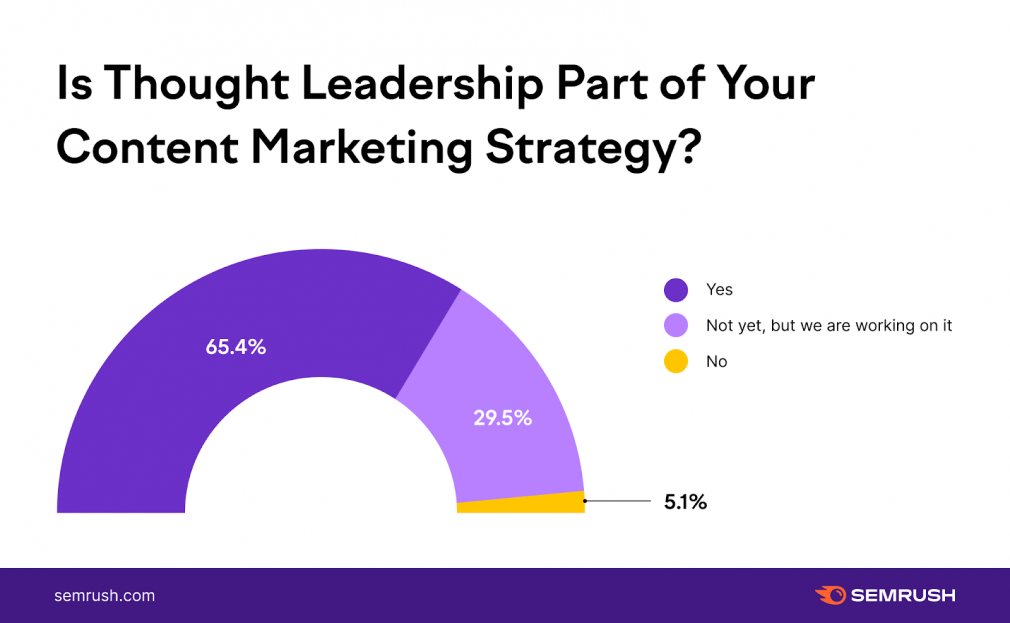
According to our research, 65% of businesses already use thought leadership for their content marketing, while 29,5% more are planning to start doing so soon.
Incorporating thought leadership into your wider content strategy can help you to:
- Establish the credibility and authority of your brand. There is a cyclical element here; when you have something valuable and original to say, it increases your profile. As your profile increases, more people will then care about what you have to say, allowing you to become an authority in your niche. Thought leadership also reinforces your brand story. You can push important ideas that you want your audience to believe in, and drive a change in their perspective.
- Generate backlinks, shares, and mentions. In itself, thought leadership is not necessarily an SEO strategy, but, when done well, it increases the likelihood that people will want to link to your content, strengthening your SEO profile as a result. This assumption is coming from the fact that for thought leadership to be successful, it should include unique opinions, research, etc., all of which also naturally encourages others to share and reference your content.
That said, you shouldn’t only publish thought leadership articles for this purpose; this, as Gibbon argues, can “dilute your content” and lessen its impact. Mentions and shares can also help you to organically grow your online presence, and ensure that your content is being put in front of relevant audiences.
- Attract clients directly. Thought leadership articles are not really intended to convert prospects directly, but they help you build a loyal audience and, eventually, attract customers.
Here’s how Geri Stengel, founder and president of Ventureneer, explains it:
As a result of my thought leadership on women entrepreneurs and entrepreneurial funding, I have gotten clients. In other cases, clients haven’t needed to check references because they knew what I stood for.” If your marketing goals are B2B-oriented, then it’s worth thinking more about thought leadership in this way.
Geri Stengel, founder and president of Ventureneer
Now that you know what thought leadership is and why it should matter to your organization, how can you start advocating it in your content?
How to Build a Thought Leadership Strategy
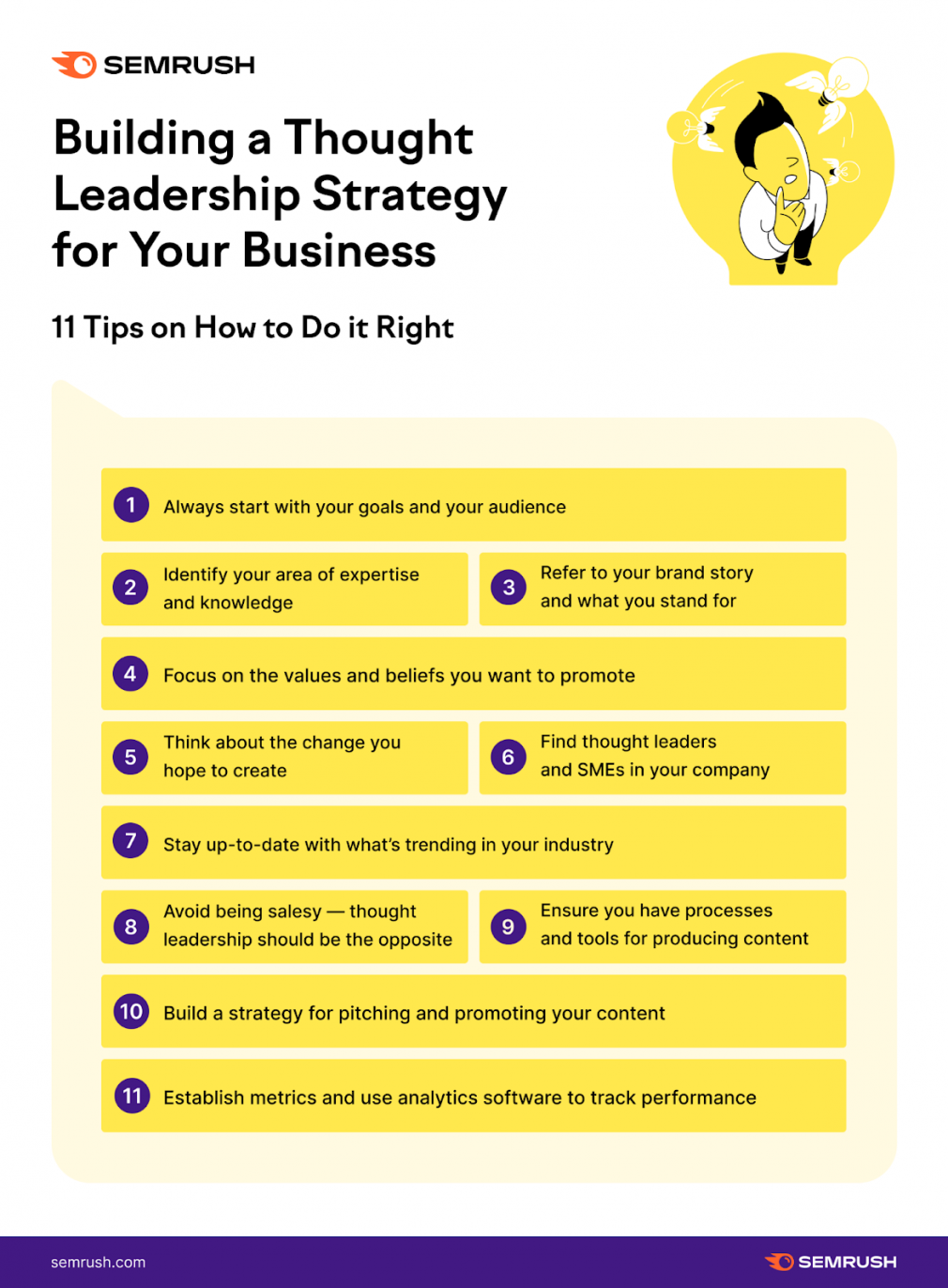
There is no one-size-fits-all approach to implementing a thought leadership strategy; many elements will depend on the stature and makeup of your business.
As a general guide, though, there are several core steps that should be followed, regardless of your company’s size.
Step 1: Define Your Goals
As with any strategy, the first port of call is to identify what exactly you want to achieve by adopting this approach.
To do this, consult your existing marketing goals, and consider how thought leadership can help you achieve each one — if indeed it can. For example, if your goal is to raise awareness of your brand (and the solutions it’s offering), then a thought leadership piece about, say, accessibility issues facing consumers in your industry can help you get people’s attention.
Defining Your Audience
An essential part of this step is to also clearly define who your audience is. These people would be aligned with your buyer persona(s), although you should also consider who might benefit the most from hearing what you have to say. For instance, are you looking to communicate directly with other CEOs? Purchasing decision-makers? Marketing managers?
You should also remember that your audience doesn’t necessarily equal your buyers. Your thought leadership strategy might go beyond reaching folks who can purchase from you. In many cases, you would want to reach wider audiences who would help spread the word about your company, become part of your community and act as brand advocates. Go back to your goals and see whether this approach makes sense for your particular situation.
Step 2: Review Existing Thought Leadership
Once you’ve identified your goals and your audience, the next step is to do some research and see what thought leadership already exists in your niche.
Explore the various communication channels in your industry, such as:
- Online forums and communities
- News resources (online and offline)
- Trade publications and journals (online and offline)
- Personal brand platforms, such as LinkedIn and Medium
- Company blogs
- Social media
- Webinars and seminars
- Conferences
Then, start building up your knowledge of what the key existing thought leadership trends and ideas are. Not only will this help you to get a better understanding of the main issues in your industry, but it will also allow you to familiarize yourself with who its primary thought leaders currently are.
Pay attention to your competitors too. What kinds of stances are they taking? How are they delivering their thought leadership content (if they are at all)? Analyze what they are doing and keep it in mind when applying your own thought leadership strategy.
Download a Free Competitive Content Analysis Template
Finally, don’t forget to look internally. Go through your company’s previous blog posts or communications to assess what your organization’s position has been on certain topics in the past. This will ensure that you don’t inadvertently alienate existing customers if you suddenly come out with a controversial idea that contradicts a previous position.
Step 3: Identify Your Organization’s Focus and Its Thought Leaders
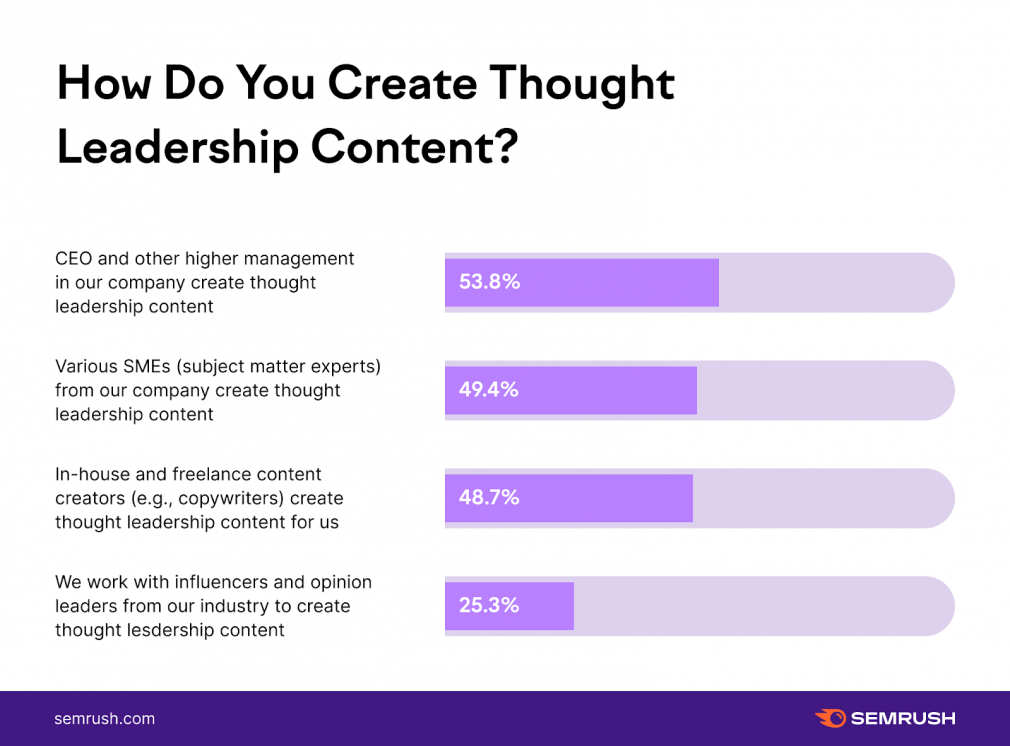
Based on our survey, CEOs and other higher management folks create thought leadership content in over 50% of companies. SMEs of all kinds create content in 49,4% of businesses, while 48,7% of companies also let in-house and freelance copywriters take over this task.
Many respondents highlighted that it's common for copywriters to craft the actual content, while SMEs, CEO, managers, etc. are always involved in this process.
So, how can you identify the right Thought Leaders in your business?
- Before you start creating your content, you first need to understand where your thought leadership lies on an organizational level. For instance, as a company, what is your expertise? What do you specialize in?
- Then, you need to consider your wider brand story and beliefs. Is there some bigger agenda or change you are trying to make as a company?
These are good starting points when deciding who your company’s thought leaders are going to be. After all, for thought leadership to be effective, the people delivering it have to be authentic and even revolutionary.
As you may want to talk about a variety of topics, it’s a good idea to build out a roster of thought leaders. Think about the key experts working in your company. Here are some aspects to look at:
- Alignment with your brand and its values. If your thought leaders are not firm believers in what your brand is all about, and are not aligned with your story and your position, then it’s unlikely to work.
- Knowledge and expertise in the field. Another thing that can truly move the needle is passion. Being both knowledgeable and passionate about what you do will naturally make others follow.
- Strong opinions, innovative ideas, and concepts. Note that there will always be a risk of making someone unhappy about your beliefs. And, that’s totally fine, as you can’t appeal to everyone (especially when it comes to thought leadership). Use your brand story and brand values as your guidelines and make sure you know your audience really well.
- Experience creating content, which can include writing and speaking skills, past appearances on webinars, events, etc. It’s also helpful if they can “prove” their credibility with credentials or memberships of relevant associations.
- Existing following, which goes beyond having a social media following. However, this comes with time and some thought leaders will grow together with their company.
According to Mindi Zissman, president of Zissman Media, it’s important that thought leadership comes directly from the mouth of experts.
I’m a big believer in leveraging SMEs for content. Their ideas are directly from the field and are usually the most original because they’re out there everyday solving the problems of your customers. As a result, you should always ensure that your SMEs get the byline on your content too. It increases the credibility of the content, and when the SME shares it on their social, the reach in your target audience is amplified.
Mindi Zissman, president of Zissman Media
Step 4: Create Your Thought Leadership Content
The next step is to actually start creating your content.
Researching Your Topics
There’s no one exact way to source thought leadership content; a good starting point can simply be to take what you already know about your goals and your audience, and then use this to start generating content ideas.
As mentioned in Step 2, one of the most important parts of this process is to be clued in on the latest trends in your niche. As Stengel, an avid business publication and social media reader, explains: “I keep my finger on the pulse of what’s going on. But I also speak to other thought leaders and ecosystem players in my field.”
Doing this allows you to get an idea of the issues your audience cares about, and can ensure that your content gets traction quickly.
Leveraging specialist tools, such as a Topic Research tool, can also make it more efficient to discover trending topics. These trending content topics for your chosen keyword can provide you with a wealth of potential ideas.
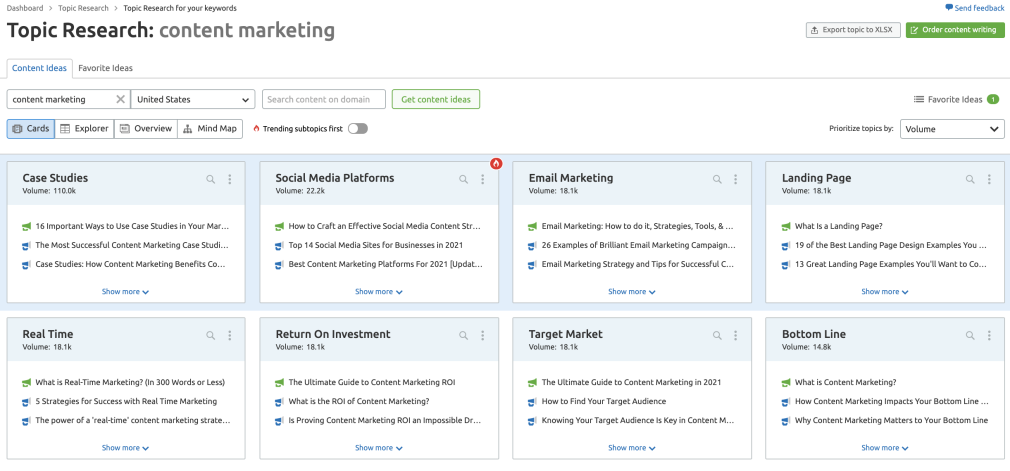
Other Sources of Ideas for Thought Leadership Content:
- Your/your thought leaders’ unique experience. For example, imagine that you developed a new way of solving a problem, or have a successful case study you could share with others.
- A strong opinion embraced in your company that goes against the industry norm (here you might want to go back to your brand story).
- Unique data and statistics you can access due to the nature of your business. It might be coming from your product, your customers, or additional research you carry out.
- Industry research and insights. This is a great place to encourage your SMEs to share their opinions and expertise, and/or use your company resources to generate relevant data.
- Collaboration with your customers and partners.
- Collaboration with existing opinion leaders and influencers in the industry.
- Your personal story and background. People love stories, especially those that are personal. For example, a founder could share a story about something that happened to them when they were building the company, and talk about the key learnings they acquired in the process.
Types of Thought Leadership Content
Thought leadership content can exist in nearly any shape and form, from blog posts to podcasts and videos. Here are the most popular thought leadership content formats, according to our research:
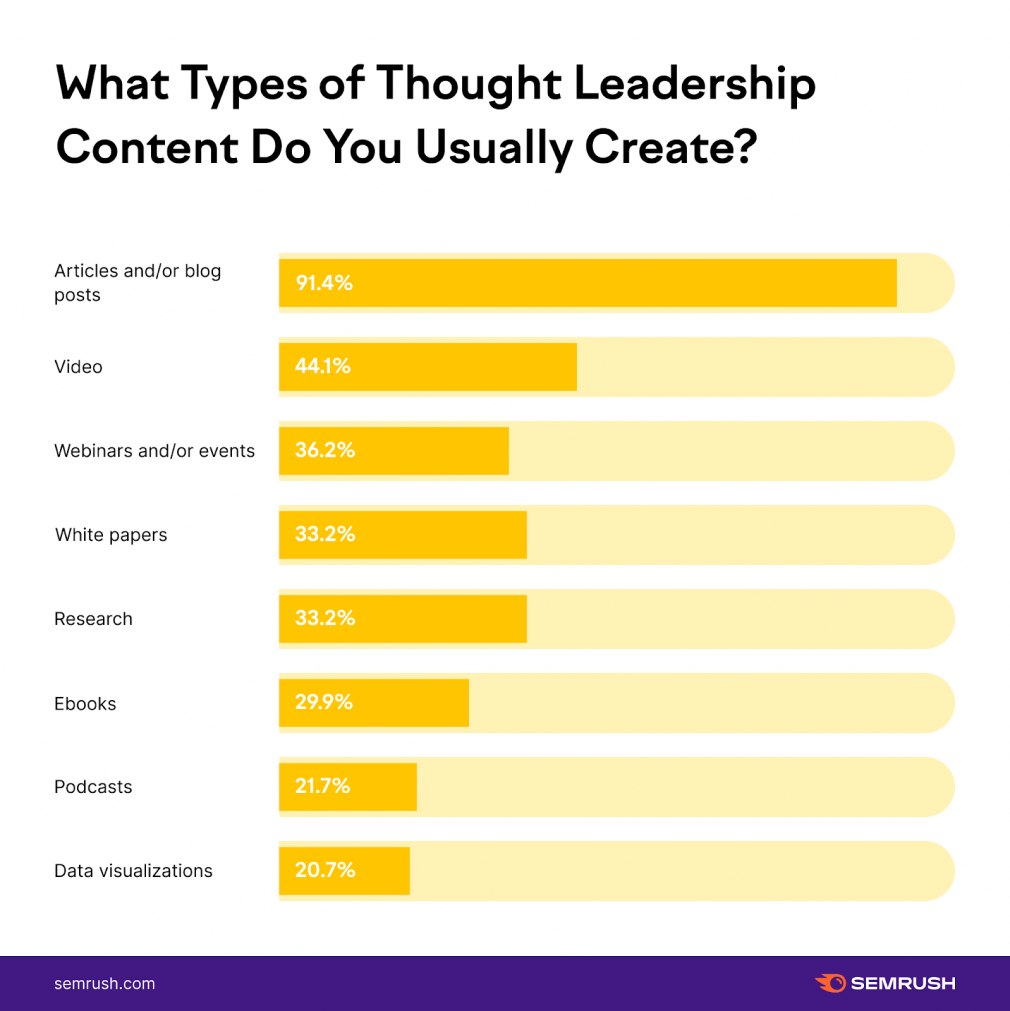
Producing Thought Leadership Content
Our study shows that articles remain the most popular thought leadership content format (91,4%), followed by video (44,1%), webinars/events (36,2%), white papers and research (33,2%), ebooks (29,9%), podcasts (21,7%) and data visuzalitions (20,7%).
When it comes to creating the thought leadership content, there are a few things to bear in mind:
- Consider how the content will be produced. As you start to build your content plan and assign topics to your thought leaders, a critical step is to determine who will actually produce the content. For instance, is the thought leader going to write it themselves? Will it be ghostwritten? Will it be structured as an interview on a podcast?
For example, if some of your SMEs have good speaking skills, make sure to let them represent your company at podcasts, webinars, events, etc.
It’s also great to have thought leaders that are good writers. The reality is, though, it’s not that common — and not that essential. The quality of writing is important, but you can always outsource the actual content creation. What should be coming from you are the actual ideas, opinions, stories, data and analysis.
So, if you feel that asking your SMEs to write the copy themselves would be too much of a burden for them, or that their writing skills are far from perfect, you can always work with a professional copywriter. The copywriter could interview the SMEs and then turn this information into appealing content.
If you don’t have an in-house writer, then you can outsource your content writing, and/or leverage various software solutions. For example, you can use Semrush’s SEO Writing Assistant tool to maintain the tone and quality of the piece, point out any readability and originality issues, and make sure that it is fully optimized for search engines. It can also be extremely useful if the content is created by your internal SMEs.
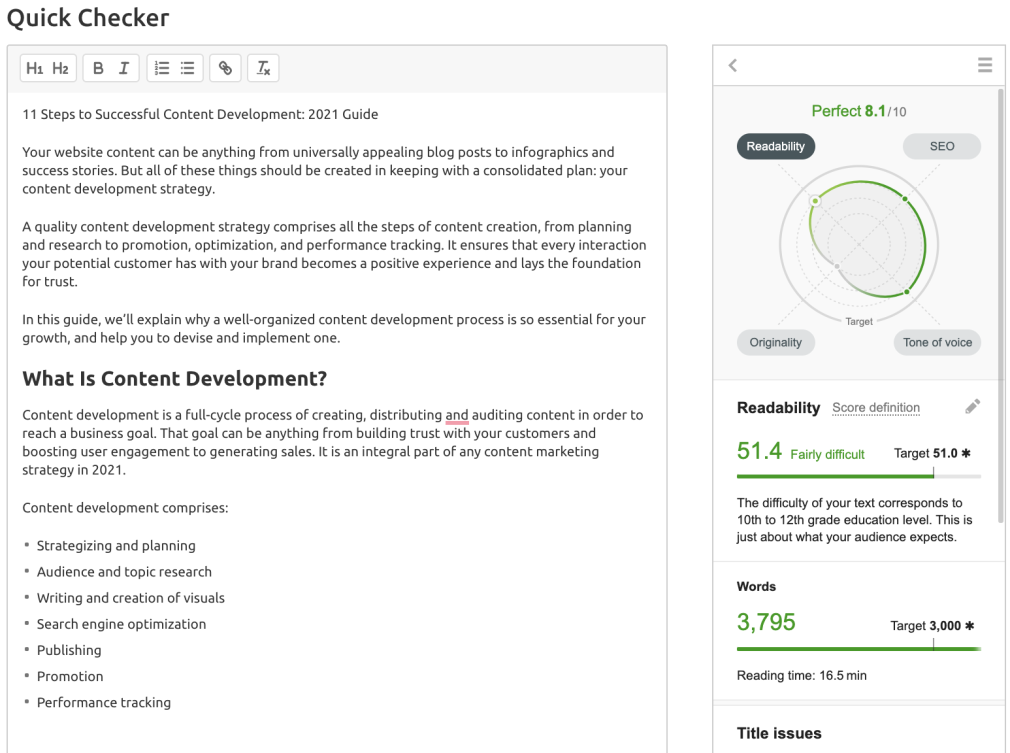
- Ensure that you’re being open and genuine. As mentioned, thought leadership content should be honest, transparent, and produced with a genuine desire to help others.
A lot of businesses fall into the trap of boasting or trying to sell. But you should give transparency to your business. You don’t have to give away your most important secrets, but you should share your learnings, show your process, and add those insights. Not only do you gain thought leadership, but you gain trust too.
RaShea Drake, a marketing director at Essential Hub
In other words, you can’t just create a blog post based on a dozen other identical blogs that already exist and present it as thought leadership. It should be something you actually believe in and something coming from your real-life knowledge.
- Stay flexible. We’ve already established that there is a close relationship between thought leadership and industry trends, so it’s important that you stay fluid in terms of editorial and publishing calendars. Trends and emerging news can change quickly, so always be prepared to react accordingly.
Can a Small Company or a Startup Create Successful Thought Leadership Content?
Absolutely! Giant, well-known organizations with extensive resources tend to organically become thought leaders in their sectors. And yet, thought leadership is all about you creating value, building knowledge, and taking a stand. Small businesses and startups with strong ideas and experienced leaders have the same chances of being heard and followed.
Is Thought Leadership Only Suitable for B2B Companies?
Has thought leadership traditionally been a part of the B2B environment? Absolutely. Does it mean that B2C businesses can’t leverage it as well? Absolutely not.
Since thought leadership is all about sharing knowledge and unique opinions, there’s no reason why it can’t (and shouldn’t) work in B2C. The rules are the same: make sure you understand your customers, do some research, be genuine and deliver valuable information.
Step 5: Distribute and Promote your Content
You can write the most interesting, useful, and insightful content, but it matters little if it doesn’t get read (or heard) because it can’t be easily found. Strategies and tactics around the distribution and promotion of your thought leadership content — and any valuable content, for that matter — are a vital component of a thought leadership campaign.
If, as mentioned, your thought leaders may already have their own network of contacts who are willing to help promote their thought leadership, then the content is more likely to generate engagement and feedback.
Depending on the topic, it can also be effective to promote this content on your company’s channels — internal and external — and even ask others within your organization to share it. For larger businesses, tools like GaggleAMP might be of use.
Pitch to journalists, publications, and other industry influencers, too, as the more authentic and opinionated nature of thought leadership content can often generate a lot of extra attention and interest.
SMBs and startups usually find it more difficult to get exposure for their thought leadership content, so it might be a good idea to consider some of the following tactics:
- Collaborate with non-competing brands in your sector to produce joint thought leadership content. Sometimes, it’s even a good idea to form alliances if you are trying to push the same agenda (e.g., digitalization in your sector).
- Reach out to relevant opinion leaders and influencers to get contributions (and extra promotional support) for your thought leadership content. Consider asking for quotes and interviews.
- Try services like Help a Reporter to pitch your content to journalists: you might not have a PR team, but it’s still possible to get some media mentions.
- Analyze content creators in your industry: find out which themes they're talking about right now and create relevant content and encourage them to share it. For example, it could be something that validates their point of view or provides new insights on the topic.
If you have a budget for paid promotion, consider adding sponsored content to your strategy. For example, if you posted a thought leadership article on your blog, you can repurpose it into a blog post published by a third party. You could also have the blog’s author appear on sponsored webinars, events and podcasts.
The Importance of Engagement
Thought leadership is about creating a conversation, so ensure that you follow through and engage directly with the communities, leaders, players, and influencers that are discussing your piece.
In a larger organization, you may have brand or reputation management personnel that can handle this, but in a smaller organization, your thought leader may need to be more involved.
Keep an eye on whether your thought leadership content is being discussed elsewhere too. You can use a Brand Monitoring tool to see when your brand is being mentioned, allowing you to reach out to the people that are interested in your products/services and content.
You can also search for community platforms, forums, Slack channels, and other spaces that connect experts in your field. For example, if your target customers belong to the startup world, you might want to be active on platforms like GrowthHackers and GrowthMentor.
Step 6: Measure the Results
As with any marketing tactic, it’s important to measure the performance of your thought leadership content. According to Gibbon, standard content metrics can offer a base level of insight.
Social listening, web analysis, brand research, and rudimentary measures (such as gated signups, downloads, and reads) are indicators,” he says. “Above all, I’m looking for outcomes, so that’s what I strive to measure.
Tim Gibbon, founder and director of Elemental Communications
Drake also relies on traditional performance metrics, but she is conscious of how her thought leadership can impact sales too. “I keep tabs on my sales and support teams to see what they’re seeing,” she says. “If it’s making their lives harder, then I’m not doing my job well, but if they’re seeing positive feedback, then I am!”
Here are the key types of results you can generate with thought leadership content, based on our research:
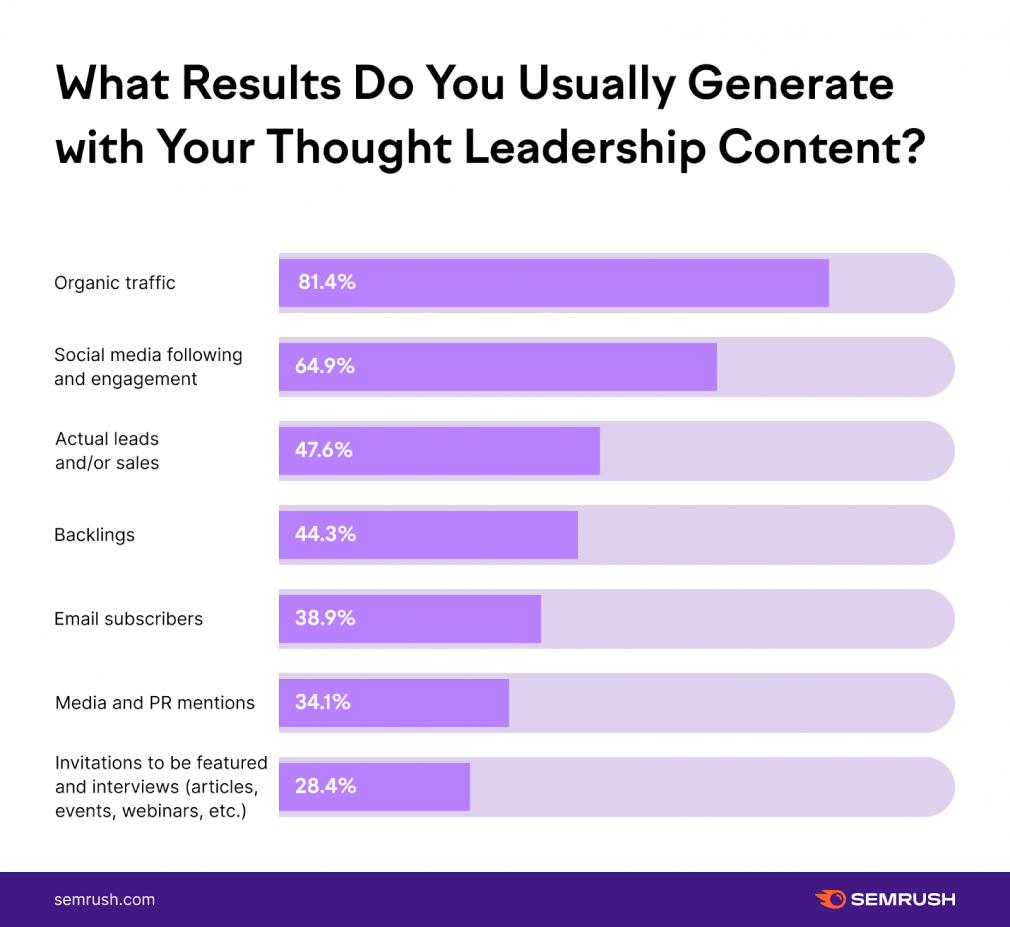
Judging from our survey, organic traffic is the key benefit of producing thought leadership content (81,4%). Besides, a big proportion of companies also manage to boost social media following/engagement (64,9%), and almost one half generates the actual leads and sales (47,6%). Other benefits include backlinks (44,3%), email subscribers (38,9%), media and PR mentions (34,1%), and invitations to speak at events, interviews, etc. (28,4%).
That said, you shouldn’t be afraid to get a little creative, especially if you’re trying to measure very specific goals.
For example, Erin Browner, a content manager at Clever Inc, regularly hosts thought leadership webinars and sends out rating-based surveys to all attendees after each event. She also monitors whether her webinars have attracted the right target audience. “If, for instance, we are seeking to engage with directors, we’ll measure how many have registered and attended,” she says. For Browner, this is a far more important metric than the overall number of registrants/attendees.
Tools for Measuring the Effectiveness of Your Thought Leadership Content
Therefore, it’s vital that you measure the impact of your thought leadership content in line with your goals. Analytics software can help in this regard; for instance, Content Audit (used to analyze your website) and Post Tracking (used to track your external publications) and tools can offer deep insights into your content performance, and suggest actionable areas for improvement.
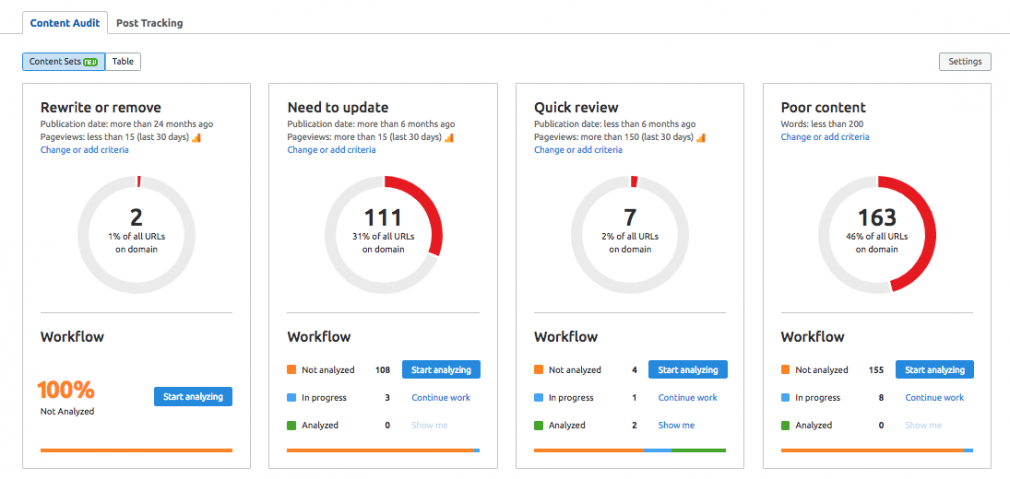
Successful Thought Leadership Examples
Thought leadership is a crucial strategy for client-facing consulting firms like KPMG, PwC, and McKinsey. They are able to leverage an extensive roster of SMEs within their business teams, and lean on not just the personal networks of those executives, but also the wealth of primary data and information that those firms possess .
KPMG’s blog is a good example of how to execute thought leadership in this format, with various senior figures across the company’s network contributing their written insight on a variety of important topics. Most of these pieces are supplemented by the company’s surveys and data, lending weight and credibility to what is being said.
The health and wellness vertical can be a minefield when it comes to thought leadership, as everything you say needs to be credible, reliable, and backed up by genuine scientific evidence.
Probiotics brand Seed leverage this to their advantage, though, focusing on the idea of how bacteria affects our health as a whole. Rather than focus on the promotion of their product, they opt to educate users (and, indeed, their influencers) about the science and sustainability behind probiotics, and how their product fits into this.
Rather than simply pushing another dubious health product, the company has used thought leadership to differentiate itself from its competitors and become an authoritative presence in its niche.
YouTube
As the CEO of the world’s biggest video content platform, it’s little surprise that Susan Wojcicki is so adept at delivering her thought leadership in a visual way.
Her series of “Creator Letters” — where she gives her thoughts on not just YouTube’s plans, but on video content and vlogging in general — involve Wojcicki narrating over a series of custom animated videos. These animations supplement the message being delivered and add a more emotive element to thought leadership, structuring it as a story rather than a seminar.
While you might not have access to resources such as animators and illustrators, YouTube’s approach does prove that you shouldn’t be afraid to get creative when delivering your thought leadership messages.
Kings Chambers
In industries that often rely on more traditional — and, in some cases, outdated — marketing methods, thought leadership can lack inspiration and fail to engage.
Kings Chambers, a UK-based law firm specializing in medical negligence, decided to address this in 2018 by starting a thought leadership podcast. Aimed at both lawyers and non-lawyers, it provides an array of insights and opinions into the legal industry (and particularly the medical negligence sector), allowing the firm’s senior barrister, Nigel Poole, to position himself as an established and respected thought leader in the field.
By going against the grain of tired industry standards and trying something new, Kings Chambers have proved that there are different ways to attract audiences with your thought leadership content.
Final Thoughts
Thought leadership requires authenticity, deep expertise, and ideas that strive to challenge the conventional way that things are done. To communicate all of this effectively, it needs to take the form of high-quality content on topics that are relevant, and that your audience really cares about.
Therefore, it’s crucial that you conduct in-depth topic research, and put out content that is engaging and unique. One of the tools that could help in this regard is the Content Marketing Platform. It allows you to explore and identify relevant trending topics in your niche, and then produce content that will rank organically and hook audiences.
Build a Powerful Thought Leadership Strategy
Find content ideas, optimize copy created by your SMEs and boost its performance with Semrush Content Marketing Platform.

Recommend
About Joyk
Aggregate valuable and interesting links.
Joyk means Joy of geeK